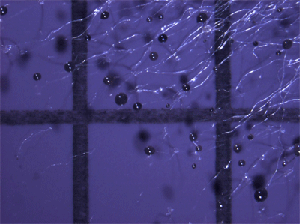
D. purpureum. (Photo by Chandra Jack, Rice University)
Found in soils worldwide, slime molds such as Dictyosteliumdiscoideumare perhaps best known by their behaviors in the presence or absence of food. When food is plentiful, the social amoeba behave as individuals, but when food is scarce, they come together to form multicellular “fruiting bodies” that look like a flower bud atop a single stalk or foot composed of a fifth of the amoebae that have sacrificed themselves for the group.
Studying social amoebae allow researchers to learn more multicellularity because they can exist in both single-cell and multicellular states. From a bioremediation perspective however, slime molds are important candidates in cleaning up sites contaminated with chemicals and radioactive materials.
In the February 2011 issue of Genome Biology, researchers led by Adam Kuspa of Baylor College of Medicine and DOE JGI Fungal Genomics head Igor Grigoriev offer a second Dictyosteliumgenome, and compare the 33-million base draft sequence produced using the Sanger platform with the finished genome of the model organism D. discoideum.
Separated by just 400 million years of evolution, Dictyosteliumpurpureum is a closerelative of D. discoideum and shares many of the same characteristics. Aside from their food-related behaviors, they also have a highly sophisticated recognition system that allows them to distinguish same-species Dictyostelium from others. The team found that the “genes involved in sociality evolve more rapidly, probably due to continuous adaptation and counter-adaptation.”